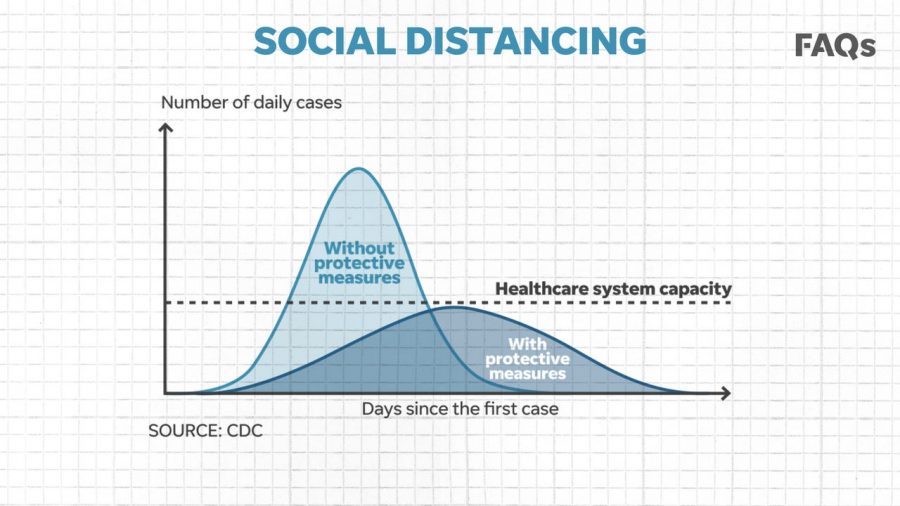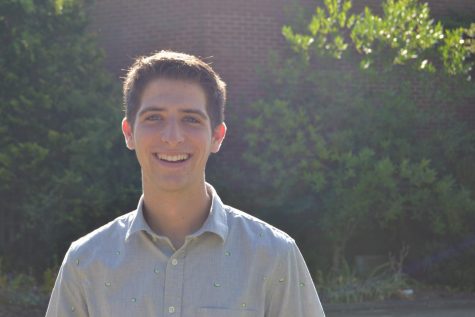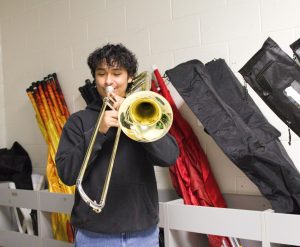OPINION: Covid-19 affects everyone, and everyone should respond
CDC
Although it may feel as though the Covid-19 virus has no implications on teenagers, this graphic from the CDC shows that preventative measures, including social distancing, from every member of society can have extremely beneficial impacts in the long term.
Mar 19, 2020
It would be easy to take these indefinite weeks off of school to relax with friends and treat it as an extended spring break. But it is vitally important for high schoolers to understand this situation for what it is: an emergency. And though the risks and dangers of Covid-19 may seem remote and not applicable to high schoolers, in reality, this is an unprecedented threat that can only be contained with participation from every member of society.
I first want to address the misconception that youth are entirely immune to the Covid-19 virus. The Center for Disease Control (CDC) specifies that “children do not appear to be at higher risk for COVID-19 than adults;” however, it clearly does not state that children are at a lower risk for the infection than their older counterparts. Additionally, younger people with pre-existing health conditions are still endangered. Respiratory infections and diseases in particular, when combined with the novel coronavirus, have proven to be able to hospitalize children. Although this data should be striking, the far more concerning matter is the ability of youth to transmit the disease without knowing.
One of the largest issues with this Covid-19 outbreak is the rapid and total spread of the virus. Transmission is easy, and in our travel-heavy, globally-connected world, it has taken seemingly no time for the disease to have a widespread international presence. Even though the younger generations seem to not be suffering from the disease itself, they can still carry and transport it as effectively as anyone else. We, as teenagers, can exchange the virus between ourselves and thus to our parents. While some sources of the media may portray that only the very elderly, with whom we may have less contact, are threatened, this is far from the truth. In fact, the latest CDC reports show that 20% of Americans hospitalized by the virus are between the relatively young ages of 20 to 44. While high schoolers may not yet be in this age range, we are surrounded by family members, guardians, teachers, coaches, and friends who are. It is, therefore, our responsibility to protect these people in any way we can.
I have always been against living my life in fear. But I have also been taught and firmly believe that it is one’s impact, not his or her intention, that matters. While my intention may be merely nothing more than spending some time with friends to take my mind off of the monotony of endless days, my impact may be much more extreme. There is always the chance that my actions lead to my infection, and the unknowing spread to my family and loved ones who are at risk of serious illness. Though that would never be my intention, that could realistically be my impact.
So I believe that it is of utmost importance that we as teenagers and high schoolers also engage in the growing practice of ‘social distancing.’ Defined by the CDC, this process involves “remaining out of congregate settings, avoiding mass gatherings, and maintaining distance (approximately 6 feet or 2 meters) from others when possible.” Simply, this method is just avoiding contact with other people, especially in large groups. Dining at restaurants, playing sports with friends, shopping, and other social, group-oriented activities can all be eliminated during this international emergency. And though may seem like a tough task, at the end of the day, it is far favorable to the full lockdown enforced in locations including Italy, California, areas of New York and parts of China.
And if you still don’t believe that Covid-19 poses a real enough threat to you, consider a separate potential medical emergency you may face. Widespread social distancing will objectively reduce the number of people infected with the virus and the number of patients in our already overwhelmed hospitals. Then, when we teenagers have another, more standard reason to use our healthcare system, from an emergency appendectomy to treatment for the normal strain of flu, it isn’t overwhelmed and won’t turn us away.
Whatever reason you chose, whether it be out of your own protection from Covid-19, looking out for loved ones who are at a higher risk, or wanting to help our hospitals, I ask that everyone attempts to engage in social distancing. It is impossible to say what the future will hold with mandated lockdowns, quarantines, and closings. But ultimately, the more action we take now and the more preventative measures we put into place, the better off we will be.











